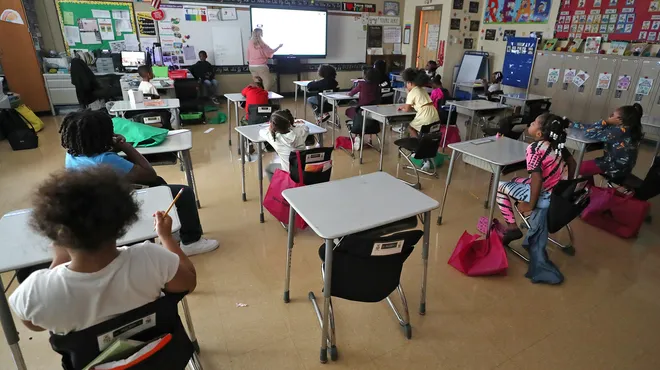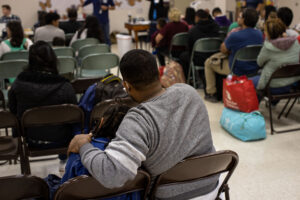Cur’ra McCoy is one of millions of students who missed weeks of school over the past few years. Instead, the Baltimore teen often slept in or played on her phone. She did a whole lot of nothing, for the most part. McCoy blames her absences on boredom, which led to her not doing well in some classes. That made her dislike school even more.
“When I don’t do nothing, I don’t feel like doing nothing at all,” the 18-year-old said. “So I stopped trying.”
Chronic absenteeism – when students miss at least 10% of the school year – has become an epidemic in America’s schools. While educators and advocates hoped attendance would improve after the instability of the pandemic, in many cases it has become more pervasive and intractable. Between 2018 and 2023, the chronic absenteeism rate nearly doubled – from 15% to 26%.
The problem, which has contributed to lower performance even among students who aren’t chronically absent, became one of the most pressing challenges this past school year. The American Enterprise Institute, a right-leaning think tank, has described it as “the biggest problem facing schools right now.” And it’s not just low-income youth who are missing class time: Students across the socioeconomic spectrum are skipping school at record-high rates.
Why has the problem become so grave? The causes are usually complex and multidimensional. Here are five key explanations for why chronic absenteeism has reached epidemic levels.
COVID made school attendance hard.Why aren’t kids (or teachers) returning to class?
Kids are bored and disconnected.
McCoy, the Baltimore teen, loved math when she was little. She appreciated its simplicity, the fact that it’s a universal language.
But as she got older, she says she started “slacking.” The instruction became boring, zapping her energy and will to put in effort. In eighth grade, she decided math was no longer for her. By the time she got to high school, she began failing some of her classes.
“We barely had any activities,” said McCoy, who said she learns best when she gets one-on-one support. “When I started getting worse at math, I just stopped coming.”

A nationally representative poll published in April found that nearly 2 in 3 teens say school is boring. Just 2 in 5 of the roughly 1,000 respondents said they liked going to school, while almost a third said going is a waste of time. Such disengagement leads to absences. And sometimes, schools’ strategies for handling absenteeism – like fines for truancy – exacerbate rather than solve the disengagement.
Get the Daily Briefing newsletter in your inbox.
The day’s top stories, from sports to movies to politics to world events.
Delivery: DailyYour Email
In her junior year, McCoy started getting tutored and mentored through a company called Concentric Educational Solutions, whose staff also occasionally visited her home to check in with her. Her attendance began to improve, as did her grades. She appreciated the personalized attention she got from her tutors, especially a mentor named Raiana Davis. Davis would come to get her on days she had slept in, McCoy explained. “It just made my energy change.”
McCoy graduated early this month and she aspires to become an engineer. She plans to enroll in college or pursue her career through the Navy.
They’re struggling with mental health issues.
Many children decide not to attend school because of poor mental health. These challenges, especially among adolescents, have worsened in recent years, with more than 4 in 10 teens reporting in 2021 that they felt persistently sad or hopeless. One analysis in Los Angeles found anxiety and depression were the top health-related reasons kids missed class.
School avoidance – when children refuse to attend or struggle being in school for the entire day – is a growing problem. USA TODAY has reported on this type of refusal becoming pronounced since the COVID-19 pandemic.
One student, Anna, described the heart palpitations and body shakes she felt in the mornings as she approached her high school campus. It wasn’t that she didn’t want to go to school, she told USA TODAY, but that she couldn’t. “It’s scary because it’s not voluntary at all,” said Anna, who asked to be identified only by her first name because of stigmas faced by people with mental illness. “It’s just kind of happening to you.”
Refusing to attend:School avoidance is becoming a mental health crisis.
They’re being bullied.
Bullying, which is pervasive in many schools, prompts kids to avoid school, too. Just a third of teens in the April EdChoice poll said they felt their school was adequately addressing bullying. Separate research reveals students who are bullied are more likely to miss class.
In a recent segment, NPR’s Morning Edition featured a sophomore in Colorado named Neomi who’s been chronically absent. Asked what was behind the absences, Neomi cried as her mom explained she’d been bullied and taunted after a breakup. Her peers laughed and talked behind her back. “I don’t have friends,” the sophomore said. “I don’t have any people.”
When students have limited connections with adults, their odds of missing school are greater. Surveys have found that fewer than a quarter of teens and preteens say many or all of their teachers try to understand what their lives are like outside of school.
They’re confused about the rules.
During the pandemic, families were instructed to keep kids out of school at any sign of illness. The rules evolved as society gained a better understanding of COVID-19. The ever-shifting protocols fueled confusion over what to do when a child has the sniffles or complains about a headache.
Hedy Chang, the founder and executive director of Attendance Works, says this puzzlement has persisted among parents. “We were pretty dramatic about quarantining and staying home, and I still think there’s a lot of confusion,” she said. “At the same time, we said to people, ‘If you’re worried about being ill, shift to online learning. … That’s just as good as learning in person.’”
Those messages have had “lasting effects,” according to Chang, and many schools no longer have a virtual option for sick days.
USA TODAY regularly visited a pair of elementary schools in Virginia last year to understand, among other questions, why chronic absenteeism has persisted. One school distributed thermometers so parents could check if children who said they weren’t feeling well were truly too sick to attend class. It also hosted educational coffee hours and published a checklist on its homepage to help families determine what to do when a kid appears symptomatic.
The other school discovered higher absenteeism rates on Mondays – a day many students’ parents had off work. Perhaps parents were keeping their children home that day because it was the only time they could spend together, school officials concluded. That finding hinted at another ripple effect of the pandemic: the perception among some families that school is optional.
During quarantines and closures, kids learned from computers at home. Daily in-person attendance has felt less critical to certain parents ever since. This attitude plays out in different ways for different families. A single mom who needs her high schooler to care for her 2-year-old while she is at work might request the teen skip school. An affluent family that wants to go on a two-week vacation might choose to do so during school days to avoid the crowds.
“Whatever your chronic absenteeism level was pre-pandemic, it tended to double,” said Chang, alluding to the problem’s impact across income levels.
As absences have worsened across the board, they’ve also exacerbated disparities, according to Chang. High-income families are more likely than lower-income ones to be able to afford resources – such as summer test prep and tutoring – to make up for lost time.
They’re navigating family, safety or transportation challenges.
Some kids aren’t showing up for school due to family hardships or fears about campus safety. Housing insecurity and poverty continue to disrupt low-income students’ routines.
Many schools have made it more difficult to enter buildings over fears of active shooters and other dangers, Chang said. These well-intended policies have, in some cases, created divisions between families and educators.
Logistical problems are another obstacle. USA TODAY shadowed during some home visits with Concentric in Baltimore this spring. The company’s staff stops by the residences of families whose children have been flagged by their schools as chronically absent. At one home, a mom named Lynetric Brightful was parking just as the Concentric van pulled up. Her adolescent son hadn’t been showing up for school, the Concentric engagement specialist and driver noted. “What resources can we help you get?” he asked.

Brightful explained that she works two jobs and has to leave early – before her son wakes up. It’s difficult to ensure he attends class by the 7:45 a.m. start time, especially since he has to take a couple of city buses to get there, trekking through dangerous neighbors often before sunrise. Her husband recently died, and she has no one else to rely on for help. She had lost another job previously because she was staying home in the morning to drive her child to school.
School transportation options are limited in Baltimore, a problem that has affected more and more districts across the country. Nationally, school bus ridership is in decline, in part because of staff shortages, service changes and delays.
Brightful began to cry when Johnson told her his organization would try to provide support. She’d been desperate for a solution, and it seemed like no one was willing to help. Without better transportation, she feared her son would continue to miss school.
“I have to do what I have to do to live,” she said. “I’m trying my best.”
Author:: Bagombeka Job
CREDIT:: USA TODAY











































